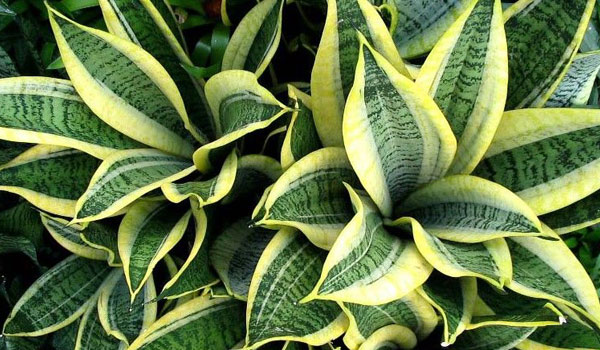Mother In Law Plant Care & Grow (Full Guide)

No matter what you call it, mother in law plant, sansevieria trifasciata, viper’s bowstring hemp, St. George’s sword, or snake plant, this is one of the all-time favorite houseplants around the world. The noticeable popularity of the mother in law tongue plant is not by accident, it is elegant, it is low-maintenance, and offers several benefits.
As a future or current owner of this plant, or as someone who is simply fascinated by this beautiful species, you will find all the information you need about mother-in-law tongue plant care, varieties, propagation, etc.
Mother In Law Plant Info
As e member of the Asparagaceae family, up until a few years ago mother in laws tongue was scientifically known as sansevieria trifasciata. It was later classified as dracaena trifasciata due to its many undeniable similitudes with Dracaena species. In this article, however, we will use its more familiar botanical name here and there.
Known for its stiff, sword-like leaves, this evergreen perennial is a tropical plant native to West Africa. mother’s tongue plant can range anywhere from six inches to eight feet tall with various foliage. In most varieties, you see green-banded leaves with yellow borders.
Mother in laws tongue flower is another lovely highlight of this houseplant. In the spring, the tubular, fragrant, creamy white blooms show themselves and adorn the plan at night. Although attractive, mother in law tongue plant blooms are quite rare.
This is a convenient plant to grow (some even consider it indestructible), but before talking about its care tips, there are some questions surrounding this plant that we want to answer first:
What Does a Mother In Law Plant Look Like?
As mentioned, you can identify this plant by its thick, tall, and sword-like shape leaves that are supposed to resemble the sharp tongue of the mother-in-law!
How to Encourage Mother In Laws Tongue Flowers?
When grown outdoors and its water, sun, and humidity requirements are ideal, snake plant blooms annually. But when grown indoors year-round, mother in laws tongue flowers rarely bloom. If you were lucky enough to witness these charming blooms, you will not need to deadhead them, as they drop on their own.
What Are Mother In Law Tongue Plant Varieties?
Some of the well-known varieties of sansevieria trifasciata are:
- trifasciata ‘Compacta‘: also known as dwarf snake plant, it has unique evergreen foliage with yellow edges.
- trifasciata ‘Goldiana‘: You can identify this beautiful snake plant by its dark green, thick leaves with broad golden margins and faint marbled banding.
- trifasciata ‘Hahnii‘: also known as bird’s nest snake plant, its leaf clusters resemble s bird’s nest clump. This small variety only grows up to six inches tall.
- trifasciata ‘Silver Hahnii‘: this miniature has silvery-white, small, flat, and succulent leaves with has no stems above ground.
- trifasciata ‘Laurentii‘: you can identify this snake plant with the creamy yellow margins that its leaves have.
- trifasciata ‘Silbersee‘: this one produces striking, silver-grey leaves that grow from a central rosette that clumps as ages.
- trifasciata ‘Twisted Sister‘: growing about 15 inches tall, this variegated mother in law plant features twisted leaves with yellow edges.
- trifasciata ‘Bantel’s Sensation‘: Displaying narrow leaves with white stripes, this variety grows about three feet tall.
What Are Mother-In-Law Tongue Plant Benefits?
As recognized by NASA, this plant does a perfect job in purifying the air and absorbing cancer-causing pollutants and toxins such as formaldehyde, nitrogen oxide, benzene, xylene, and trichloroethylene.
Is Mother-In-Law Tongue Plant Poisonous?
Yes, sansevieria trifasciata is toxic to both dogs and cats. The toxic component in this variety is known as Saponin, which has a foaming effect leading to gastrointestinal discomfort or disrupting normal cell pathways that cause cell death.
Can You Put a Mother In Law’s Tongue Outside?
Thanks to its hardy nature, you can grow this plant outdoors as well in pots or in the ground if you live in warm climates. In cold climates, it is better to keep it as an indoor plant.

Mother-In-Law Tongue Plant Care
Whether you are a beginner or a professional, growing this tolerant plant is going to be an absolute joy with minimum effort:
Water
As a drought-resistant plant, the mother in law plant is susceptible to overwatering which leads to root rot. To avoid this problem, water your snake plant only when its potting soil feels dry.
In warmer months, do not water more than every two weeks. During colder months, water every month or whenever the soil is dry. Do not you are under-watering your plant, as it can even go two months between waterings in the winter.
Light and Temperature
Snake plant is a tropical plant that grows in shade to partial sun in its natural habitat. As a houseplant, it is best you locate it in a spot with indirect but steady light with some direct sun. They also survive in full sun or dimly lit conditions.
Mother in law plant grows best in warm weather. But in cold conditions? Not so much. Therefore, provide it with a condition that that is not too cold. Temperatures between 70- and 90-degrees Fahrenheit are best. Keep in mind that frost and long exposures to temperatures below 50 degrees Fahrenheit can affect your mother’s tongue plant or even kill it.
Humidity
Although it can tolerate dry air conditions and (only occasional) drafts, average house humidity is advised in mother-in-law tongue plant care.
Soil
This species thrives in sandy, well-drained soil with slightly acidic to slightly alkaline pH. That means your plant will be happy in any loose potting mixes with proper drainage (like an all-purpose cactus potting soil).
Since sansevieria trifasciata prefers sandier soils, we recommend using a soil mix that is low in peat content. This is because peat can become tightly packed and create some problems in draining.
Feeding
Use fertilizer for mother in law tongue plant during its main growing seasons. In spring and fall, feed with a diluted cactus and succulent fertilizer every month. Do not fertilize in the winter.
Potting and Re-potting
Only repot your plant and refresh its soil when necessary. That is when the pot cracks from growth. This is because this species does not enjoy repotting very often. Use a clay pot (snake plant’s strong roots can easily crack weak pots) and use gloves to handle the mother in law plant to avoid skin irritations. Keep in mind that it is better to re-pot your plant in spring.
How To Trim Mother-In-Law Tongue Plant?
You can trim the mother in law plant with sterile scissors or a sharp knife. To prune and encourage new growth, remove marred, damaged, or mature leaves at the soil line during the growing season. You can prune during the off-season too, but it may stress out your plant.
Tip: To control the plant’s height, remove the tallest leaves.

Mother In Law Tongue Plant Propagation
You can propagate this plant successfully in spring or summer via root division, leaf cuttings, or new offshoots.
For propagation via root division follow these instructions:
- Pull the mother in law plant root system out. Gently brush the soil away from the root ball or rhizome with your hand.
- Divide the plant into sections with a sharp knife while each section’s roots remain intact. This will not kill your plant, do not worry.
- Plant the new sections into a clean pot with a suitable potting mix, water, and place it in a location with partial sun.
For mother in law’s tongue propagation using leaf cutting follow these steps:
- Cut a long, healthy leaf from your plant with a sterilized sharp knife.
- Place the leaf cutting in a clean jar of water. Locate the jar in a partially sunny spot and wait until the cutting roots. While waiting for the roots to develop, add water every few days to keep the water level. Also, change the water every two weeks to prevent bacterial or algae growth.
- You can also skip the last step. In this case, all you need to do is let the mother in laws tongue cutting to callous over for 24 hours and then proceed to the next step.
- When the roots are at least an inch long, plant it in a popper potting mix, water, and place it in a spot with partial sun.
Once you notice new pups at the base of the plant, follow these instructions to propagate new offshoots of your mother’s tongue plant:
- Remove the root structure out of the pot, find the offshoot’s root, cut it off, and plant it in the potting media.
- Water it and place it in a spot with indirect bright light.
Mother In Law Plant Common Pests and Problems
scales, gnats, spider mites, aphids, mealybugs, and whiteflies are among the houseplant pests that can harm your beautiful sansevieria trifasciata. By providing what your plant needs and keeping it happy, it can handle these insects with no problem.
But if your plant suffers from environmental issues like incorrect irrigation, humidity, etc., it cannot block the invasions If you notice insects on your plant, remove them by picking them off or a gentle spray of water, or treat them with neem oil.
However, sometimes the insects are not the problem. Apart from over-watering that shows itself ad fungal infections or root rot, keep an eye for these mother-in-law tongue problems as well:
- Yellow or brown leaves indicate over-watering, pests, or root rot.
- Curling leaves can be a sign of a pest infestation by thrips that you can treat with neem oil or vegetable soap.
- Leaves falling over or drooping show over-watering, insufficient light, or poor potting soil with no drainage.
- Rotted-smelling soil tells you that there is root rot. In this situation, pull the root ball out, remove brown, mushy roots, or leaves, and repot the healthy root rhizome in fresh soil. If the rhizomes are beyond saving, discard them and propagate a new mother in law plant from leaf cuttings.
- In this post:
- Mother In Law Plant Info
- Mother-In-Law Tongue Plant Care
- How To Trim Mother-In-Law Tongue Plant?
- Mother In Law Tongue Plant Propagation
- Mother In Law Plant Common Pests and Problems



